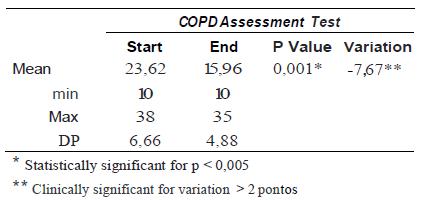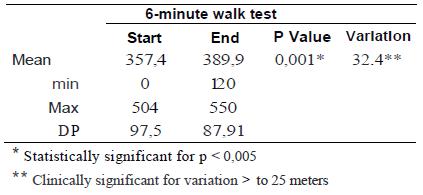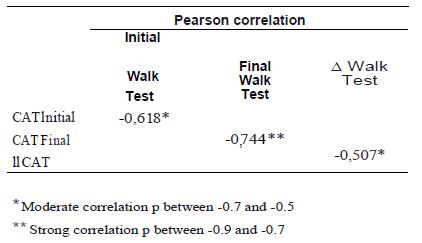Servicios Personalizados
Revista
Articulo
Indicadores
-
 Citado por SciELO
Citado por SciELO -
 Accesos
Accesos
Links relacionados
-
 Similares en
SciELO
Similares en
SciELO
Compartir
Revista Portuguesa de Enfermagem de Reabilitação
versión impresa ISSN 2184-965Xversión On-line ISSN 2184-3023
RPER vol.2 no.1 Silvalde jun. 2019
https://doi.org/10.33194/rper.2019.v2.n1.01.4566
Articles
Effect of Pulmonary Rehabilitation assessed by CAT and its relation to activity tolerance
1- Centro Hospitalar e Universitário São João
Chronic Obstructive Pulmonary Disease (COPD) is a common disease characterized by progressive airflow limitation, causing important functional impairment with repercussions on self-care. Previously characterized only by dyspnea, it is now recognized that a more comprehensive symptomatic assessment is needed, leading GOLD to recommend the COPD Assessment Test (CAT), among others.
Pulmonary Rehabilitation (PR) is the non-pharmacological treatment recommended in this context, and for that reason the goal of this investigation is to understand its effect on CAT as well as its relation with functional capacity (FC).
Quasi-Experimental Study with a Respiratory Rehabilitation Program (RRP) with a median duration of 13 weeks, with the effect on CAT and FC evaluated at the beginning and at the end.
Forty five patients were included: 80% men, mean age 65.82 years and mean forced expiratory volume in the first second (FEV1) of 40%.
Statistical and clinically significant improvements were found in both CAT and FC, with a moderate negative correlation between the two.
We conclude that this RRP reduced symptoms and increased FC in people with COPD.
Key words: Rehabilitation Nursing; Pulmonary Rehabilitation; CAT; Exercise tolerance; COPD
A Doença Pulmonar Obstrutiva Crónica (DPOC) caracteriza-se por limitação crónica, progressiva e não totalmente reversível do fluxo aéreo, limitando por vezes o autocuidado.
Anteriormente caracterizada pela dispneia, reconhece-se atualmente a necessidade de uma avaliação sintomática mais abrangente recomendando-se entre outros instrumentos o COPD Assessment Test (CAT).
Sendo a Reabilitação Respiratória (RR) o tratamento não farmacológico recomendado neste contexto é objetivo deste estudo perceber qual o seu efeito no CAT e sua relação com a capacidade funcional (CF).
Estudo Quasi-Experimental com programa de Reabilitação Respiratória (PRR) de duração mediana de 13 semanas sendo o efeito no CAT e na CF avaliados no início e no final.
Incluidas 45 pessoas: 80% homens; idade media 65,82 anos e FEV1% medio 40%.
Verificou-se melhoria estatística e clinicamente significativas no CAT e na CF existindo entre as duas uma correlação negativa moderada.
Concluímos que este PRR reduziu a sintomatologia e aumentou a capacidade funcional em pessoas com DPOC.
Descritores: Autocuidado; Enfermagem de Reabilitação; Reabilitação Respiratória; Self-Care; Rehabilitation Nursing; Pulmonary Rehabilitation
La Enfermedad Pulmonar Obstructiva Crónica (EPOC) se caracteriza por una limitación crónica, progresiva y no totalmente reversible del flujo aéreo, provocando limitaciones funcionales importantes repercutidas en el autocuidado.
Anteriormente caracterizada únicamente por la disnea se reconoce actualmente la necesidad de una evaluación más amplia de los síntomas y se recomienda entre otros el uso del COPD Assessment Test (CAT).
La Rehabilitación Respiratoria (RR) es el tratamiento no farmacológico recomendado en este contexto, la meta de este estudo es saber cuál es su efecto en el CAT y su relación con la CF.
Estudio Quasi-Experimental con programa de Rehabilitación Respiratoria (PRR) de duración mediana de 13 semanas, 3X semana siendo su efecto en el CAT y en la CF evaluados al inicio y al final.
Se incluyeron a 45 personas: 80% hombres; edad media 65,82 años y FEV1% medio de 40%.
Se observó una mejora estadística (p < 0,001) y clínicamente significativas en el CAT y en la CF existiendo una correlación negativa moderada.
Concluimos que este programa de RR redujo la sintomatología y aumentó la capacidad funcional en personas con EPOC.
Palabras clave: Rehabilitación Pulmonar; CAT; Tolerancia a la actividad; EPOC
INTRODUCTION
Chronic obstructive pulmonary disease (COPD) is characterized by persistent airflow limitation.
In recent years there has been an increase in mortality and morbidity and it is estimated that it will be the third cause of death in 2020. 1) (2
In Portugal, comparing the patient’s records between 2011 and 2017, there was an increase from 54,000 to 136,958 cases, being the currently estimated prevalence of 14.2% for those over 40 years old, which should be around 800,000 people. 2
The degree of obstruction is associated with many symptoms of the disease; however it is poorly predictive of dyspnea and quality of life. 1) (2) (3
In fact, respiratory function does not explain all the symptoms of the disease, resulting activity intolerance not solely from the loss of pulmonary function, but associated with impaired gas exchange and peripheral muscle dysfunction causing muscle fatigue (especially of the lower limbs) and dyspnea with important impact in self-care and quality of life. 3
This fact led Global Initiative for Chronic Obstructive Lung Disease (GOLD) to propose, since 2011, a new stratification of the disease, combining the risk of exacerbation, spirometry and symptomatic assessment 1.
Symptoms resulting from the disease, especially dyspnea, activity intolerance and loss of lung function lead to the recognition of Respiratory Rehabilitation (especially due to the exercise training component) as a non-pharmacological treatment indicated for people with COPD. 2) (3) (4) (5 Provided that intervention of Rehabilitation Nurses must meet the individual needs of the person, increasing tolerance to the activity fundamentally through exercise training and the educational component, promoting functional independence and the adoption of healthy behaviors. 4) (5
In this context, the initial assessment of respiratory rehabilitation programs is essential to determine the impact of the disease on the person, as well as understand the individual response and the health care sensitive gains of the respiratory rehabilitation program. 3) (4) (6
In this sense, data on dyspnea, activity tolerance and quality of life should be evaluated, which can be easily collected using the COPD Assessment Test (CAT). 4) (5) (6
This questionnaire contains eight questions centered on respiratory function data: cough, sputum, dyspnea and limited chest expansion and also on non-respiratory data such as activity intolerance, sleep disturbances, and inability to perform activities of daily living. 3) (4) (7
The CAT is a short assessment tool that simply quantifies the various impacts of disease symptoms and was developed to assess the health status and also to simplify communication between the sick person and the healthcare team.
It consists in 8 items answered along a 5-point Likert scale, with a maximum disease score of 40 points.
It is a self-administered questionnaire where scores range from 0 to 10 (mild), 11 to 20 (moderate), 21 to 30 (severe) and 31 to 40 (very severe). 3) (4) (6) (7
The recent 2019 GOLD report recommends that people with a CAT greater than 10 points be stratified as highly symptomatic. 2
A decrease of 2 points in the CAT questionnaire is considered a relevant gain in health, making this value the least clinically significant difference, which is a very important indicator since it translates gains in health. 8
This study aimed to evaluate the effect of a respiratory rehabilitation program on the symptoms perceived by people with COPD assessed by the CAT and to understand its relationship with activity tolerance
In this sense, there were two questions that guided this investigation:
METHODS
Type of study
It is a quasi-Experimental Study with a respiratory rehabilitation program with an average duration of 13 weeks, 3 sessions per week.
Each session lasted an average of 1 hour and included exercise training. The educational session was held in the classroom and lasted 60 minutes. 9 (Table 1)
Sample
The sampling technique used was non-probabilistic for convenience and consisted of people with COPD who completed the respiratory rehabilitation program in the Kinesitherapy and Respiratory Rehabilitation Sector of Centro Hospitalar e Universitário de São João.
Inclusion criteria follow the GOLD recommendations published in 2019. 1
Exclusion criteria used were failure to fully comply with the respiratory rehabilitation program, disability and/or formal contraindication for physical exercise, psychiatric illness or severe cognitive impairment, and exertion induced hypoxia refractory to oxygen.
Data Collection Instruments
The impact of the respiratory rehabilitation program on symptoms was assessed through the self-completion of CAT before and after the rehabilitation program.
The intensity of exercise training was assessed by the Cardio-Respiratory Exertion Test and the 1RM test according to the ERS/ATS guidelines. 4) (5) (9) (11
Functional capacity was assessed at the beginning and at the end of the respiratory rehabilitation program using a six-minute walk test (variations after clinical intervention equal to or greater than 25 meters translate to clinical improvement). 4) (8
Statistic analysis
In the analysis and statistical treatment of data, descriptive and inferential statistics were used.
Statistical treatment was performed using a nonparametric test for 2 related samples (Wilcoxin signed-rank test) for the variables under study
The statistical treatment was performed using the IBM® SPSS® Statistics version 23.0 program.
All data were expressed with mean values and standard deviation (SD) with a statistical significance level of 0.05 for all statistical tests.
Table 1 Respiratory Rehabilitation Program
| RESPIRATORY REHABILITATION PROGRAM | |
|---|---|
| PHYSICAL COMPONENT | |
| Muscle Strength Training (30 minutes) | Endurance Training (30 minutes) |
| • Upper limbs • Biceps • Triceps • Deltoid • Lower limbs • Quadriceps • Hamstring • Gastrocnemius • Pectoralis major • Latissimus dorsi |
• Cycle ergometer • Lower limbs • Upper limbs • Rug |
| EDUCATIONAL COMPONENT | |
| Educational sessions (60 minutes) • Changes in the respiratory process • Benefits of exercise and maintenance of regular physical activity • Management of therapeutic regimen |
• Energy management techniques • Controlled ventilation techniques • Prevention and early treatment of exacerbations |
This study was conducted in accordance with the required ethical imperatives, having guaranteed all deontological assumptions inherent to research ethics.
RESULTS
The study included 45 people (71.9% men) with a mean age of 65.82 years old with a mean FEV1% of 40%. (Table 2)
Table 2 Sample characterization
| N | 45 |
| Male | 36 |
| Female | 9 |
| Age | 65,82 years-old (Max:83, min:49) Standard deviation:11.01 |
| FEV1% | 40% (Max:70.6; min: 11.2) Standard deviation:17.57 |
| Initial six-minute walking test | 357.4 meters (Max:504; min: 0) Standard deviation: 97.5 |
The CAT results show a statistically improvement (p < 0.001) in the overall test result with a mean variation of -7.67 (Table 3).
Functional capacity had a statistical (p = 0.001) and clinically significant variation with a mean variation of 32.4 meters in the six-minute walk test (Table 4).
Finally, it was found that there is a negative correlation between the two variables studied, more accentuated in the values after the respiratory rehabilitation program. (Table 5)
DISCUSSION
This investigation aimed to assess the impact of a respiratory rehabilitation program on symptoms and to understand its relationship with activity tolerance in people with COPD.
Our investigation obtained results that overlap with those results found in the most recent published scientific evidence; they obtained clinically significant gains both in the symptoms variable (assessed by CAT) and in the functional capacity variable (assessed by 6MWT).
We also verified that there is a negative correlation between the two variables, more exacerbated in the results after the rehabilitation program, which can be explained by the fact that exercise training improves cardiovascular capacity and reduces oxygen consumption, leading to a consequent improvement in dyspnea and tolerance the activity.
Another important finding in our investigation supports the importance of individualizing rehabilitation programs, since the impact on daily life activities and social interaction achieved clinically significant gains, despite the variability found.
As mentioned above, respiratory rehabilitation is the non-pharmacological treatment indicated for the treatment of people with COPD, being a combination of complex interventions based on individualized assessment of the person that include, but are not limited to, education and exercise training. 4) (5) (9) (12 Its success is due to its effect on reducing dyspnea and muscle fatigue present in approximately 68% of people with COPD in an outpatient setting, improving their physical and psychological condition and promoting the acquisition of self-management tools for the disease. 5) (9
In this context, the initial assessment is of particular importance in order to better design and implement the exercise training program.
Likewise, it is essential to evaluate the result of our clinical practice in order to identify interventions with greater clinical benefit, as well as to provide more robustness to rehabilitation nursing care, improving not only clinical practice but also validating the knowledge guided by nursing theory.
In this context, the CAT emerges as an excellent assessment tool due to its simplicity and to translating the symptoms that usually reflect the person's problems.
Liu et al (2015) in an experimental study with a control group in a sample of 80 people concluded that despite the respiratory function being more compromised in the intervention group, the values of the walking test after respiratory rehabilitation were higher than those in the control group. This fact clearly shows that CAT is a valid instrument to assess respiratory function and activity tolerance. 11
Candemir et al (2015), in a sample of 40 people with COPD undergoing an 8-week respiratory rehabilitation program, related the results obtained by CAT with dyspnea (assessed by the MRC), quality of life (assessed by the Saint George Respiratory Questionnaire), daily life activities (assessed by the London Chest of daily living) and exercise tolerance (assessed by the Incremental Shuttle Walking test and the Endurance Shuttle Walking Test) having concluded that CAT is positively correlated with Quality of life, a dyspnea and life activities and negatively with effort tolerance. It also suggests that CAT is a robust instrument to assess the results of respiratory rehabilitation programs since it analyzes all the variables normally used as an indicator of results in respiratory rehabilitation programs. 12
Dood et al (2015) carried out a larger multicenter quasi-experimental study with a sample of 261 people with COPD, assessing anxiety, depression, quality of life, activity tolerance and quality of life in addition to CAT, having concluded that CAT is a simple, practical, viable and easy-to-complete instrument, which should be an integral part of both initial and final assessments of respiratory rehabilitation programs. 3
The same result was reached by Houben-Wilke S. et al (2018), who carried out a quasi-experimental study with 497 people with COPD and which revealed a significant improvement in the CAT and 6MWT values after the respiratory rehabilitation program. 6
CONCLUSION
The current scientific evidence is unanimous in accepting exercise training and education as fundamental pillars in the rehabilitation of people with COPD, reducing the main symptoms of the disease (dyspnea and muscle fatigue).
CAT is sensitive to these results, expressing the gains sensitive to Rehabilitation Nursing care, and should be adopted in the evaluation of respiratory rehabilitation programs.
REFERÊNCIAS BIBLIOGRÁFICAS
1 GLOBAL STRATEGY FOR THE DIAGNOSIS, MANAGEMENT, AND PREVENTION OF CHRONIC OBSTRUCTIVE PULMONARY DISEASE (2019 REPORT). GLOBAL INITIATIVE FOR CHRONIC OBSTRUCTIVE LUNG DISEASE; 2019. [ Links ]
2 PANORAMA DAS DOENÇAS RESPIRATÓRIAS EM PORTUGAL Retrato da saúde 2018 O estado da Saúde em Portugal. OBSERVATÓRIO NACIONAL DAS DOENÇAS RESPIRATÓRIAS; 2018. [ Links ]
3 Ferreira D, Gaspar L, Teodoro A, et al. Guia Orientador de Boa Prática - Reabilitação Respiratória. Ordem dos Enfermeiros ed. Lisboa; 2018. [ Links ]
4 Dood JW, Hogg L, Nolan J, Jefford H, et al. The COPD assessment test (CAT): Response to pulmonary rehabilitation. A multicentre prospective study. Thorax. 2011 Março; 66: p. 425-429. [ Links ]
5 Spruit MA, Singh SJ, Garvey C, et al. An Official American Thoracic Society/European Respiratory Society Statement: Key Concepts and Advances in Pulmonary Rehabilitation. American Thoracic Society Documents. 2013; 188: p. 13-63. [ Links ]
6 Houben-Wilke S, Janssen SJA, Franssen FM, et al. Contribution of individual COPD assessment test (CAT) items to CAT total score and effects of pulmonary rehabilitation on CAT scores. Health and Quality of life outcomes. 2018. [ Links ]
7 Kim S, Oh J, Kim Yl, et al. Differences in classification of COPD group using COPD assessment test (CAT) or modified Medical Research Council (mMRC) dyspnea scores: a cross-sectional analyses. BMC Pulmonary Medicine. 2013;: p. 13-35. [ Links ]
8 Kon S, Canavan JL, Jones SE, et al. Minimum clinically important difference for the COPD Assessment Test: A prospective analysis. Lancet Respiratory Medicine. 2014;: p. 195-203. [ Links ]
9 Garvey C, Bayles MP, Hamm LF, et al. Pulmonary Rehabilitation Exercise Prescription in Chronic Obstructive Pulmonary Disease: Review of selected guidelines. Journal of Cardiopulmonary Rehabilitation and Prevention. 2016; 36: p. 75-83. [ Links ]
10 M S, F P, al MEe. Pulmonary Rehabilitation and Physical Activity in Patients with Chronic Obstructive Pulmonary Disease. American Journal of Respiratory and Critical Care Medicine. 2015; 192. [ Links ]
11 Gloeckl R, Pitta F, Marinov B. Pratical recommendations for exercise training in patients with COPD. European Respiratory Review. 2013 Junho;: p. 178-186. [ Links ]
12 Gaspar L. Treino aeróbico e de fortalecimento muscular no doente com patologia respiratória. Enfermeiro: Anuário 2017. 2017 Maio;.(Reabilitação Respiratória). [ Links ]
13 Liu J, Meng G, Ma Y, Zhang X, Dingmei C, Chen M. Influence of COPD Assessment text (CAT) evaluation and rehabilitation education guidance on thr respiratory and motor functions of COPD patients. Open Medicine. 2015; 19: p. 394-398. [ Links ]
14 Candemir I, Kaymaz D, Ergun P, Demir N, et al. Assessment of pulmonary rehabilitation efficacy in chronic obstructive pulmonary disease patients using the chronic obstructive pulmonary disease assessment test. Expert Review of Respiratory Medicine. 2015;: p. 487-492. [ Links ]
Received: March 12, 2019; Accepted: June 27, 2019











 texto en
texto en 





